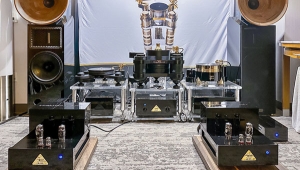| Columns Retired Columns & Blogs |
Thiel CS2.3 Loudspeaker Page 2
A faithful and observant reader, however, might draw a slightly different picture as a result of following—and extrapolating from—the evolution described in years of Stereophile Thiel reviews. JA's discussion of the CS6 earlier this year is a good example. The basic Thiel attributes are there: "excellent low-bass response . . . definition, coupled with tremendous punch," "pinpoint imaging," and "superb retrieval of recorded detail." Clear evidence of evolution and refinement appears as well, in JA's comments that the new Thiels "presented a wealth of detail without sounding too vivid or spotlit," and that "the highs didn't sound tipped up or bright on music." His 1993 CS2 2 review is another good example, where he commented that the '2 2 "had a slight tendency toward brightness, but was much better than the CS2 in this regard." I tried to approach the Thiel CS2.3 from both perspectives: as the latest point on an evolutionary curve, and in comparison to the classic CS3.6.
Technology
Thiel speakers have always been designed and built to optimize a core set of attributes: flat frequency response, time and phase coherence, low energy storage, and low distortion. These were the goals for the Thiel Model 03 in 1978, and have remained the goals for Thiel speakers ever since. The design features that these goals led to—the Coherent Source configuration and sloping front panels, curved baffles, massively braced cabinets, underhung dynamic drivers, etc.—have remained constant as well, and become high-end fixtures. The CS2.3's overall design and outward appearance are similar to those of the CS2 and CS2 2, but there are major changes under the skin.
The CS2.3 is the first speaker to use Thiel's new compound driver, for which a patent application has been filed. In this new design, the 1" tweeter and 4" midrange are mounted coaxially and driven by a single voice-coil, which responds to frequencies from about 100Hz up.
Both the tweeter and midrange use anodized aluminum diaphragms, separated by a compliant, cast polypropylene ring—sort of like the surround you find on any cone driver. Above about 3kHz, the tweeter is driven and functions just as you'd expect. Below 3kHz, it still moves but doesn't really push enough air to be a factor. The movement of the midrange, on the other hand, is controlled by the compliance of the polypropylene ring. Above 3kHz, the tweeter vibrates away, but its movements are absorbed by the compliant ring and are not transferred to the midrange cone. Below 3kHz, however, the compliant ring is effectively rigid, and transfers the voice-coil's movements directly to the midrange cone. It's simple and elegant—one of those things that seems so obvious once you see it.
The rest of the CS2.3's spec is, in fact, a refinement of previous models. The bulk of the cabinet is constructed of 1"-thick MDF and is very heavily braced. The front panel is of 3"-thick MDF and is sloped backward to bring the driver voice-coils into time-alignment on the listening axis, and contoured to minimize diffraction at sharp edges. Inside, the midrange/tweeter driver fires backward into a dedicated cylindrical cavity; the remainder of the cabinet is open to the rear of the 8" woofer and a forward-facing 9" passive radiator.
All of the drivers are made by Thiel and use rigid cast baskets, anodized-aluminum cones, and an "underhung" magnet structure. In this configuration, a long magnetic gap and much shorter voice-coil ensure that the coil will remain in a relatively constant magnetic field across its full excursion, dramatically lowering distortion. Aluminum is chosen for the drivers because it increases their rigidity and results in the driver resonances being well outside their operating range, further reducing distortion. The crossover is acoustic first-order and uses custom-made polypropylene and polystyrene capacitors and low-oxygen copper air-core inductors. A single set of binding posts is located on each speaker's underside; a set of spikes that slip into wells in the '2.3's bottom is provided for stable mounting on carpeted surfaces.
No discussion of a Thiel speaker would be complete without mentioning the cabinetwork. In fact, when I unboxed the pair of CS3.6es a few years back, their natural cherry finish made such an impression on Bonnie that she immediately revamped our kitchen-remodeling project to include natural cherry cabinets. The CS2.3s are also natural cherry with black grillecloths, and every bit as gorgeous. Fit and finish, as they say, are outstanding—these are lovely pieces of furniture.
Setup
The Thiels were auditioned in two listening rooms and mated with a wide range of associated equipment. However, most of my critical listening and notes refer to their use in my larger (17' by 22') listening room. The room has been treated with panel resonators in the front corners, and Echo Busters bass traps in the front and rear corners. I also use Echo Busters diffusers behind the speakers and listening chair, and their absorbers on the side walls at the first reflection point. The speakers were burned-in for 200 hours.
- Log in or register to post comments



































